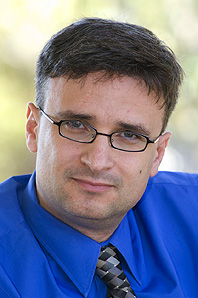Home > Press > Fluorescent nano-barcodes could revolutionise diagnostics
 |
| Dr Dimitrov |
Abstract:
A new technology with research and clinical application including the early detection of disease has been invented and developed by University of Queensland researchers.
Fluorescent nano-barcodes could revolutionise diagnostics
Australia | Posted on May 22nd, 2008A new technology with research and clinical application including the early detection of disease has been invented and developed by University of Queensland researchers.
Dr Krassen Dimitrov, from UQ's Australian Institute for Bioengineering & Nanotechnology, has developed fluorescent "barcodes" called nanostrings, offers greater sensitivity and accuracy than current detection methods.
The research has been published the prestigious international journal Nature Biotechnology.
Dr Dimitrov said nanostrings bind to RNA molecules for digital gene expression analysis.
"Because this system can count the exact number of biomolecules present we can get an extremely accurate and sensitive picture of gene expression at a particular point in time," Dr Dimitrov said.
"This quantitative data is superior to other gene expression systems such as microarrays, which rely on the analogue measurement of fluorescence and therefore are less accurate and have a limited range.
"The nanostring is an important technological development in both clinical and research settings. We will be able to more accurately detect molecules associated with particular diseases and in the research arena, we will be able to identify new molecules associated with diseases and trace these back to the genes responsible."
He said the technology is based on a non-enzymatic process which reduces the chance of bias and is more robust in a variety of different conditions.
Dr Dimitrov is currently working on the next step, which will be new nano-barcodes that will further reduce the cost and improve sensitivity and usability.
This technology has been commercialised in Seattle by a company founded by Dr Dimitrov in 2003.
The AIBN is a multi-disciplinary research institute based at UQ, which brings together the skills of world-class researchers in the areas of bioengineering and nanotechnology to produce positive health and environmental outcomes such as biomedical delivery; bio-devices; tissue regeneration; and cell therapies.
####
About University of Queensland
####
About University of Queensland
The University of Queensland (UQ) is one of Australia's premier learning and research institutions. It is the oldest university in Queensland and has produced generations of graduates who have gone on to become leaders in all areas of society and industry. The University is a founding member of the national Group of Eight, an alliance of research-strong "sandstone" universities committed to ensuring that Australia has higher education institutions which are genuinely world class. It belongs also to the global Universitas 21 alliance. This group aims to enhance the quality of university outcomes through international benchmarking and a joint venture e-learning project with The Thomson Corporation.
For more information, please click here
Contacts:
Dr Krassen Dimitrov
7 3346 3880
or
Russell Griggs
07 3346 3989
Copyright © University of Queensland
If you have a comment, please Contact us.Issuers of news releases, not 7th Wave, Inc. or Nanotechnology Now, are solely responsible for the accuracy of the content.
| Related News Press |
News and information
![]() Simulating magnetization in a Heisenberg quantum spin chain April 5th, 2024
Simulating magnetization in a Heisenberg quantum spin chain April 5th, 2024
![]() NRL charters Navy’s quantum inertial navigation path to reduce drift April 5th, 2024
NRL charters Navy’s quantum inertial navigation path to reduce drift April 5th, 2024
![]() Discovery points path to flash-like memory for storing qubits: Rice find could hasten development of nonvolatile quantum memory April 5th, 2024
Discovery points path to flash-like memory for storing qubits: Rice find could hasten development of nonvolatile quantum memory April 5th, 2024
Nanomedicine
![]() New micromaterial releases nanoparticles that selectively destroy cancer cells April 5th, 2024
New micromaterial releases nanoparticles that selectively destroy cancer cells April 5th, 2024
![]() Good as gold - improving infectious disease testing with gold nanoparticles April 5th, 2024
Good as gold - improving infectious disease testing with gold nanoparticles April 5th, 2024
![]() Researchers develop artificial building blocks of life March 8th, 2024
Researchers develop artificial building blocks of life March 8th, 2024
Discoveries
![]() Chemical reactions can scramble quantum information as well as black holes April 5th, 2024
Chemical reactions can scramble quantum information as well as black holes April 5th, 2024
![]() New micromaterial releases nanoparticles that selectively destroy cancer cells April 5th, 2024
New micromaterial releases nanoparticles that selectively destroy cancer cells April 5th, 2024
![]() Utilizing palladium for addressing contact issues of buried oxide thin film transistors April 5th, 2024
Utilizing palladium for addressing contact issues of buried oxide thin film transistors April 5th, 2024
Announcements
![]() NRL charters Navy’s quantum inertial navigation path to reduce drift April 5th, 2024
NRL charters Navy’s quantum inertial navigation path to reduce drift April 5th, 2024
![]() Discovery points path to flash-like memory for storing qubits: Rice find could hasten development of nonvolatile quantum memory April 5th, 2024
Discovery points path to flash-like memory for storing qubits: Rice find could hasten development of nonvolatile quantum memory April 5th, 2024
|
|
||
|
|
||
| The latest news from around the world, FREE | ||
|
|
||
|
|
||
| Premium Products | ||
|
|
||
|
Only the news you want to read!
Learn More |
||
|
|
||
|
Full-service, expert consulting
Learn More |
||
|
|
||








